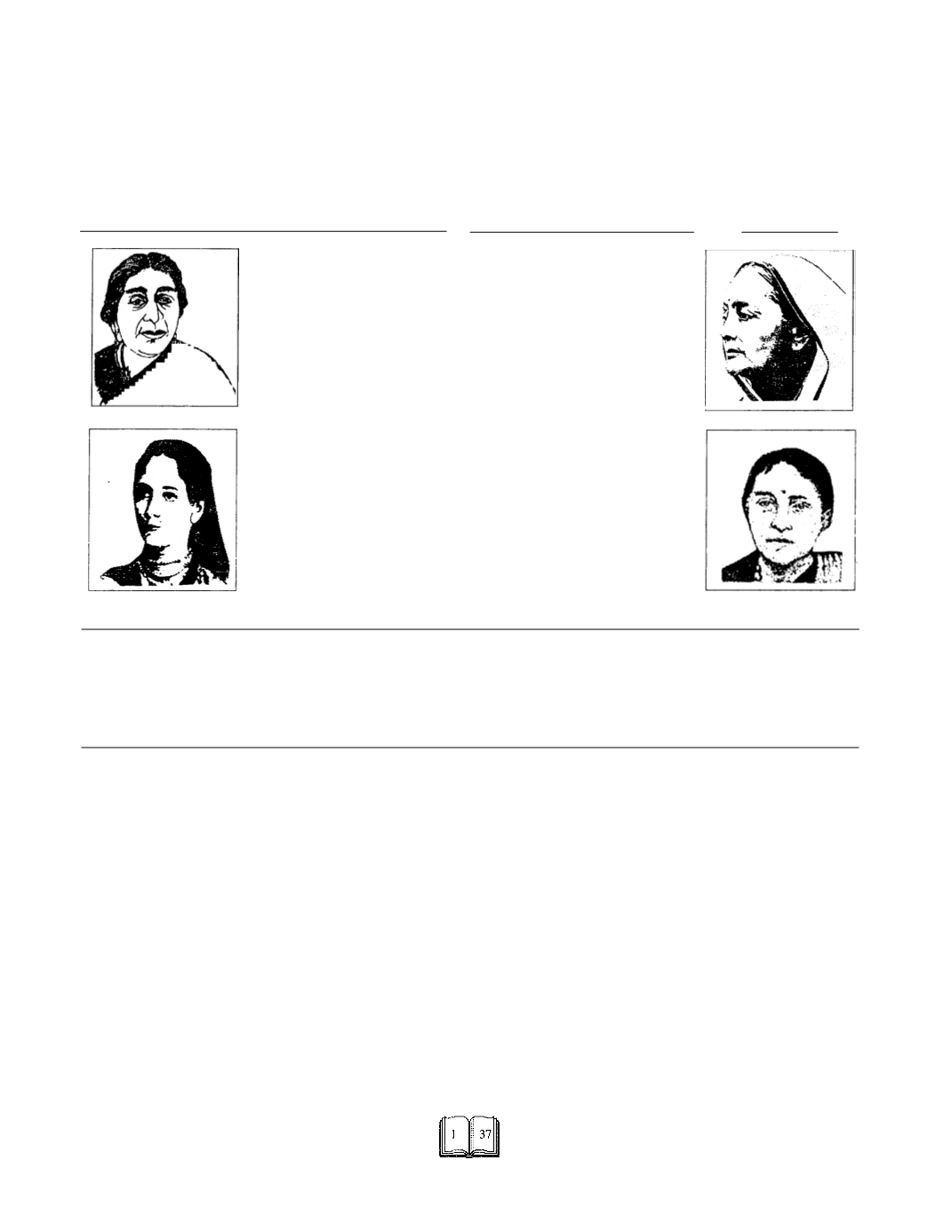

Eternal India
encyclopedia
Women's Strength in the National Movement
FREEDOM MOVEMENT
Women's fight for Franchise : Annie Besant with some other delegates to the 1926-27 session of the Women's Indian Association, Madras.
Kadambini Ganguly, first woman delegate to the Congress (1889). She was also one of the first women to graduate in medical sc iences.
Leaders during the Khilafat and Non-Cooperation movement - Bi Amma (Mother of AH brothers), Basanti Devi, Padmasini Ammal.
Shakuntala Devi of Gonda arrested during the Individual Satyagraha movement.
Women leaders of the Left movement - Kamala Devi Chattopadyaya, Bharati Ranga, Suhasini Jambekar.
Legislators : Dr. Muthulakshmi Reddy, Radhabai Subbaroyan, Vijayalakshmi Pandit, Hansa Mehta, Rukmani Lakshmipathi. Ammu Swaminathan.
Swarna Kumari Devi
Women have always been the repositories of Indian culture and they kept it
alive in song, dance and story through more than 200 years of British rule.
Many associations were formed to promote and care for women's education.
Outstanding women like Ramabai Ranade, Pandita Ramabai, Smt. P.K. Ray, Lady
Bose, Bhikhaji Cama and Shirin Cursetji dedicated themselves to opening new op-
portunities and careers for women.
The first modem organization of women was started in 1917 by the great
pioneering woman, Mrs. Margaret Cousins, in Madras under the inspiration and
leadership of that magnetic personality, Mrs. Annie Besant, and her Home Rule
Movement, which was then a dynamic stream giving expression to the people's
restless urge for freedom. Mrs. Besant was interned by the British Indian Govern-
ment as a result of this agitation, and that gave added inspiration to women.
The Women's Indian Association, though functioning mainly in the South, be-
came from its very inception a rallying point for women for action on an all-India
plane.
When Sarojini Naidu was made the Congress President in 1925, she described
it as a
1
generous tribute to Indian womanhood and as a token of... loyal recognition
of its legitimate place in the secular spiritual counsels of the nation’.
Indian women
earned the recognition by their earnest and active participation in the Indian freedom
movement in all its phases, almost from the beginning. As early as 1889, a woman
delegate, Kadambini Ganguly, took part in the proceedings of the Congress. In the
beginning of this century, another woman, Madame Cama, spoke
for the dumb
millions of Hindustan'
at the International Socialist Congress at Stuttgart in 1907.
Kamaladevi Chattopadhyaya
Congress recorded its
“admiration for the womenhood of India, who, in the hour of peril for the
motherland
...
stood shoulder to shoulder with their menfolk in the frontline of India's National Army to
share with them the sacrifices and triumphs of the struggle
26th Jan, 1931.
Resolution of Remembrance
When Sarojini Naidu was made the
Congress President in 1925 she described it as
a ‘
generous tribute to Indian womanhood and
as a token of.... loyal recognition of its legiti-
mate place in the secular spiritual counsels of
the nation
The contribution of women to the
freedom movement began with the heroic
Rani Laxmibai of Jhansi who died fighting
against the British in the revolt of 1857. Sir
Hugh Rose, Commander of the British Army
against whom she fought, paid her a well-
deserved tribute when he referred to her as the
‘best and bravest military leader of the reb-
els.’’
Movements for women's emancipation
and social reform which began to take root in
the middle of the 19th century in western and
southern India ultimately merged with the
struggle for freedom. Two great champions
who worked for the liberation of women and
the lower castes were Lokahitavadi Gopal
Hari Deshmukh and Jotiba Phule. Pandita
Ramabhai and Behramiji Malabari started a
campaign for women's uplift. In Madras the
Theosophical Society under Annie Besant
fostered patriotic pride. All these contributed
to the growth of a national outlook. Most of
the social reformers became active in the
emerging all-India political movement.
Women took an active part not only in
political agitations but also in the revolutionary
movement in the country. In Bengal in the
Provincial Conference of 1906 Sarojini Bose
took the oath that she would not wear a gold
bangle so long as the Government did not
withdraw the ban on singing the song
‘Bande
Mataram ’
and on shouting the words. During
the Swadeshi movement and the boycott of
foreign goods, Basant Devi, wife of
Chittaranjan Das, and other women courted
imprisonment.
When Mahatma Gandhi set out on his
Salt March on March 12,1930 with 75 chosen
comrades he decreed that no women were to
join him. But when he reached Dandi on April
5th he was met by Sarojini Naidu and thou-
sands of women who brought vessels with
them to carry home sea water. Mahatma
Gandhi greatly admired the courage of these
women who had never before left home and
said their part would be written in ‘letters of
gold.’ Women were by now fully included in
his movement. Sarojini Naidu was arrested
while leading a non-violent demonstration
against the salt pans near Dharsna. In August
1942 when mass arrests were made all over
India, she was jailed with Gandhi and many
others in the Agha Khan Palace.
















